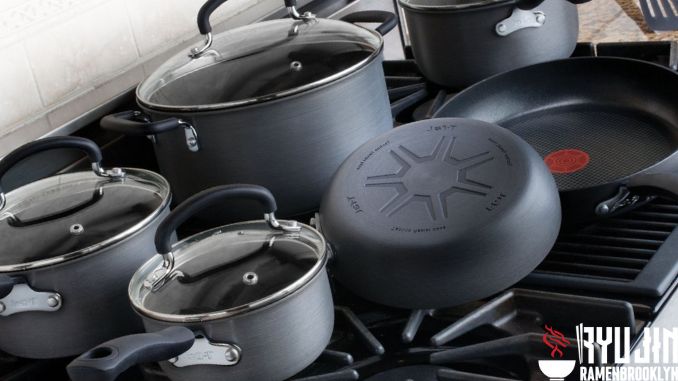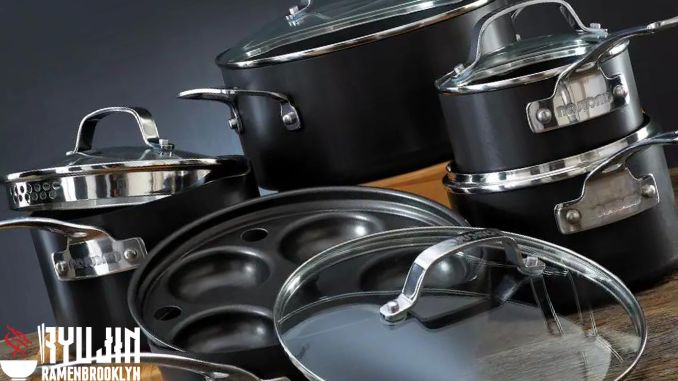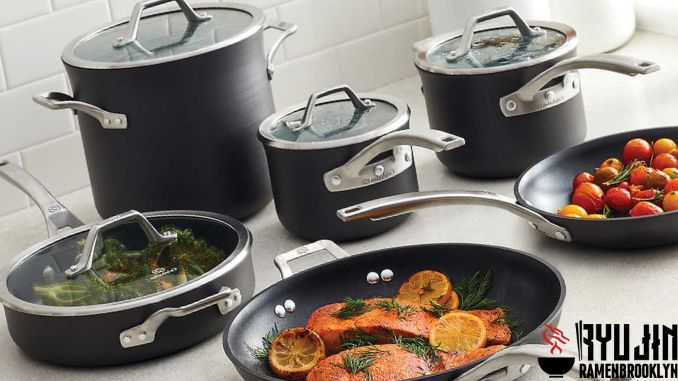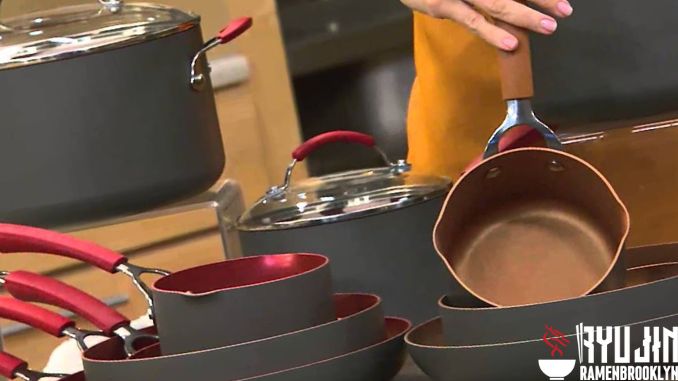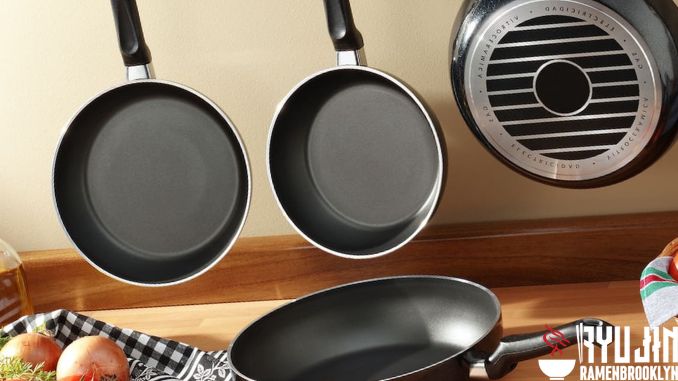What is Hard Anodized Cookware?
Cooking is a passion for many people. It’s an activity that can be done alone or with others, and the results are always satisfying. Whether you’re a novice or an expert in the kitchen, though, it’s important to have the right tools.
If you’re like most people, you may be wondering what cookware is. Cookware is a type of kitchenware that is specifically designed for cooking. It usually consists of pots and pans made from metals such as aluminum, stainless steel, or copper. Cookware can be used on both the stovetop and in the oven.
It’s important to choose the right type of cookware for your needs, depending on what you’ll be using it for. For example, if you plan to fry chicken, you’ll need a skillet with a nonstick coating. If you’re looking for a pot to make soup in, go with one that has a thick bottom so it won’t scorch the food.
There are all sorts of different types and brands of cookware available on the market today, so it can be tough to decide which ones are right for you. If you’re looking for an option that’s durable and easy to care for, consider hard anodized cookware. But what is hard anodized cookware, and why might it be a good fit for your needs? Keep reading to learn more.
- What is Hard Anodized Cookware?
- Pros of Hard-Anodized Cookware
- Cons of Hard-Anodized Cookware
- What Should You Look for When Purchasing Hard Anodized Cookware Sets?
- FAQs about Hard Anodized Cookware
- Is Hard Anodized Cookware Safe to Use?
- Can I Use Metal Utensils with Hard Anodized Cookware?
- What is the Best Way to Clean Hard Anodized Cookware?
- What is the Difference Between Hard Anodized and Regular Anodized Cookware?
- Which is Better Hard Anodized or Stainless Steel?
- Which is Better Cast Iron or Hard-Anodized?
- Which is Healthier Ceramic or Hard Anodized Cookware?
- How Do I Season Hard Anodized Cookware?
- Is Anodized The Same as Teflon?
- Do Hard Anodized Cookware Peel?
- What are Some of The Best Recipes to Try With Your New Hard Anodized Cookware Set?
- Conclusion
What is Hard Anodized Cookware?
The process of hard anodizing does exactly what it sounds like, giving aluminum steel its harder finish—literally turning them into metal that will never wear or rust away! This is due in large part thanks to oxide compounds forming on top after being electricity accelerated under high voltage conditions.
Hard anodes are created by exposing aluminum to electricity in order to create oxide, which forms on their surface as protection from corrosion over future use – this process creates stronger metal with greater resilience than if left unprotected
It’s important not just how well your pans work but also whether they’re made out of sturdy material like stainless steel or lightweight pottery bodies because those will also affect what you’re able to cook in them. If you want the best of both worlds, look for something like hard-anodized aluminum cookware. It’s as tough as any steel out there but with the even heat distribution that only aluminum can provide.
While this technique has been around since ancient times for making weapons such as swords and knives (which were often treated with vinegar), today’s technology makes possible cookware treatments that were unthinkable only a generation ago.
Hard-anodized cookware was first invented decades ago, but it didn’t have a nonstick coating. But when the 1990s became popular for this type of kitchen equipment and materials to be introduced into homes across America as they were made more affordable by companies who wanted us cooking at home more often than ever before – hard anodes started getting topped off with “non-stickers.”
Because hard anodized cookware is so durable, it’s often used in commercial kitchens. It can withstand a lot of wear and tear, and it won’t warp or scratch easily. If you’re looking for cookware that will last you for years to come, this is a good option to consider.
Hard anodized cookware is also a good choice if you’re looking for something that’s easy to care for. The nonstick surface means that food won’t stick to the cookware, making it easy to clean. And because it’s made from aluminum, it’s also lightweight and easy to maneuver.
The Process of Hard Anodizing Aluminum
The electrochemical process of hard-anodization is relatively simple. To start, the aluminum base that will make up your skillet or saucepan gets dipped in a bath containing sulfuric acid and then exposed to low electrical charges which cause its ions (which are connected networks) to soak up oxygen right away! This means they’re directly oxidized by exposure – no need for burning wood this time around because we’ve got science on our side 🙂
When heated, the metal becomes soft which allows air bubbles through – this makes for a lackluster outcome when trying to remove food from its surface or scratch pans! This is why you need to keep your pan cool and avoid heating it up.
The acid then goes into cooling mode at 32°F (0 °C) before being increased with an electric current; as soon as these steps happen rapidly enough so the outer layer anodizes quickly while still inside out a protective coating called patina, making twice strong stainless steel according to some accounts!
The key to success with hard anodized cookware is all in the timing. If the process is done too slowly, the metal will start to warp and lose its shape. If it’s done too quickly, the patina won’t have time to form and protect the metal from scratches and wear.
To get the perfect result, manufacturers use a variety of techniques to control the speed of the process. Some use high-frequency currents, while others use low-frequency currents. The type of current used will affect the thickness of the oxide layer that forms on the surface of the metal.
The final step in the process is to seal the pores of the metal so that food doesn’t stick to it and it’s easy to clean. This is usually done with a nonstick coating, such as Teflon.
Pros of Hard-Anodized Cookware
Durable
Hard-anodized aluminum is so strong, you can even use it in the oven! You may have heard that hard anodic coatings on stainless steel are difficult or impossible to remove. That’s because they’re actually designed this way – while other metals will devolve into oxide after being heated up past 600 degrees Fahrenheit ( 315 Celsius), hard anod suffers little change beyond its normal transformation rate at high temperatures. This means there’s no risk whatsoever of warping when exposed directly under flame from open flames such as gas cooktops where we often burn food items!
Enables Healthier Cooking
Because hard-anodized aluminum cookware doesn’t leach metals, it’s a healthier option than other types of cookware. No need to butter or oil the pan with this cookware because it’s non-stick. This means that you won’t have any unnecessary calories added to your diet and can reduce fat intake if needed!
Heat-Conductive
The aluminum is anodized, which means it has been coated with tin. This metal acts as a cooking surface and allows for the easy release of heat from the pan to food without any net loss in energy content within your meal because there’s no direct contact between them! The high thermal conductivity also helps ensure even heating so you won’t have those soggy pancakes or undercooked eggs anymore either – just perfect results every time.
Hard-anodized aluminum cookware is a responsive heating and cooling system that responds quickly when you change the stovetop’s temperature. This can be handy for cooking one-pot meals because it requires frequent adjustments in order to prevent overcooking or undercooking certain ingredients, like rice.
Suitability for Different Heat Sources
Hard-anodized surfaces are perfect for use on almost any indoor heat source, including electric and gas ranges. They’re also resistant to melt under intense temperatures of up 1,221°F (660 °C), making them safe enough even when heated near open flame sources like griddles or commercial burners found in restaurants all around town!
Hard-anodized cookware is a type of metal that has been heated to enhance its durability. This sort of material was originally designed for restaurant cooking, when chefs needed a durable way to keep up with nonstop frying and grilling tasks without risking their valuable equipment in quick succession while also maintaining safety concerns at all times – especially since open flames are not usually recommended near food! Camping/gourmet style appliances will be best used when you plan on cooking over fire but if it’s just gonna be some basic boiling then choose something else like copper or stainless steel instead.
Scratch-Resistant
If you’re tired of your aluminum cookware getting scratches and dings after just a few uses, then it’s time to try out hard-anodized aluminum. Hard anodes protect the surface against wear from kitchen utensils like spatulas or forks while still allowing food juices enough access so they don’t stain anything permanently stuck in these pans!
Stackable
Hard-anodized cookware has been designed with scratch resistance in mind and can be stacked without fear of damaging them. Furthermore, there are even options available specifically made to allow for stacking – such as Calphalon Premier!
This makes it ideal if you have limited space or live somewhere where apartments aren’t very spacious (like an older home). You’ll save yourself some stress during a move too since hard anodes don’t take up much room compared to other types like stainless steel pans do.
Doesn’t Leach Metals
Hard-anodized aluminum cookware is a great choice for those who want to avoid any unpleasant surprises when their food tastes like metal. Unlike nonstick coatings that wear down over time, hard anodes last longer and can withstand more abuse before they’re damaged or etched away completely by acidic ingredients like lemon juice or vinegar in your recipes!
Versatile
Hard-anodized aluminum is a great choice for those who want to cook all sorts of foods, including delicate ingredients like fish and eggs. The nonstick coating means that you can use high heat without worrying about damaging your food with minimized sticking or rehearsing – it also makes cleaning up afterward much easier than other types!
Low Maintenance
Yet another advantage of hard-anodized cookware is that it doesn’t need seasoning. Seasoning can be a complicated and time-consuming process for other kinds, such as cast iron! But not with these babies – you simply need to take proper sanitary precautions when opening your product or use kitchen wipes after use (and never eat anything off them), then they’re good to go.
Nonstick
Hard-anodized cookware is often considered stick-resistant, which means that even the stickiest foods will not leave a stain on them. The only problem with this type of pan? It’s not really “nonstick.” Most experts do consider culinary treatments for pans designed to have an anti-stick surface shield. However, there are some who don’t think they should be given so much importance when compared to natural non-sticking properties found in other materials such as Teflon or graphite. However despite these opinions maintained by many skilled chefs around town – hard aluminum does give you peace knowing your favorite pot won’
Even Heating
Another advantage of hard-anodized aluminum cookware is that it heats evenly. This means you won’t have to worry about hot spots, which can cause food to stick or burn.
Cons of Hard-Anodized Cookware
Appearance
Hard-anodized pots and pans are not the most colorful bunch. They come in dark or charcoal grey hues with dull textured surfaces, as an inevitable side effect of their process during production (stainless steel contains other metals that cause this). However, if you’re looking for some color inspiration when designing your kitchen then I have good news–most hard Naples stainless steels can also double duty as serving platters! But keep one thing in mind: these same qualities make them less durable than aluminum so be sure to use accordingly!
Price
One of the biggest downsides to hard-anodized cookware is the price tag. This type of cookware is usually more expensive than other types on the market, such as stainless steel or nonstick varieties. However, if you’re looking for a long-term investment then hard anodes may be worth the extra cost since they last much longer!
Exterior Stains
Hard-anodized aluminum is not as resistant to stains and other elements that may damage its exterior. One of the most common complaints with this type of metal cookware, however, comes from people who have had their pots or pans develop permanent marks on them due carelesslyipping over time–stains which are difficult if not impossible to remove because they burn right into the material itself!
With a little bit more effort than usual though you can actually restore your hard-anod pot or pan’s exterior back to its original condition using a number of methods (including some natural ones).
Internal Scratches
The nonstick coating on hard-anodized cookware is also susceptible to scratches, which can affect both the appearance and performance of your pots and pans. To avoid this, it’s important to use only wooden, silicone, or nylon utensils when cooking with this type of cookware. In addition, you should never cut food directly in the pot or pan as this can also damage the nonstick surface.
Heavy
Hard-anodized aluminum is a heavier metal than standard Aluminum. The difference averaging approximately 2 milligrams per square centimeter, it can be up to ten times thicker in some cases! This means that these types of cookware might feel bulky when handled or moved around by small kitchens – but they will also last much longer because there’s less chance for wear and tear on either surface due simply to brushing against surfaces within your home Kitchen area.
Quality Varies Across Brands
Hard-anodized cookware is a durable and affordable choice, but not all brands deliver the same quality. Quality varies depending on the shape as well thickness of the aluminum pan – with thicker metals providing more even heating overall! The Calphalon Premier series offers heavy-gauge pans at 3mm thick which will give you better results than medium or light-duty products if that’s what you’re looking for in terms of performance.
Incompatible With Induction
Hard-anodized aluminum is not induction compatible, so if you either have or plan to get an induction cooktop in your home hard pans aren’t the option for you. However, there are some exceptions to this rule. Pans with metal discs added on the bottom make them friendly for use in an electric stovetop–the All Clad HA1 line (view Amazon) has proved itself time after again as one such pan that can work well under these circumstances.
Not Made for Extremely High Heat
Hard-anodized metal cookware is not safe for use under a broiler or in ovens heated to over 500°F. As the famously durable material aluminum has no cooling effect at all when exposed to high temperatures, hard anodic coatings will often crack and peel off of their surface due to this stress–leaving you with harmful fumes released into your kitchen!
What Should You Look for When Purchasing Hard Anodized Cookware Sets?
Hard anodized cookware is a great investment for your kitchen. When purchasing hard anodized cookware, there are a few things you should keep in mind. First, make sure that the cookware you’re considering is made from pure aluminum. This will ensure that it’s strong and durable.
Second, look for cookware that has a nonstick coating. This will make it easy to clean and prevent food from sticking to the surface.
Third, make sure that the cookware you’re considering is dishwasher safe. This will make it easy to care for and keep your cookware looking new.
Finally, make sure that the cookware you’re considering is covered by a warranty. This will protect your investment and give you peace of mind in knowing that your cookware is covered in case of any defects.
FAQs about Hard Anodized Cookware
Is Hard Anodized Cookware Safe to Use?
Hard anodized cookware is not only safe but it also has many benefits over other types of pans. The surface material used for making this type, which includes aluminum and chromium within its composition means that the metal will never rust or Corrode easily like stainless steel can do when left unprotected against oxygen at high heat – something important to consider if you plan on storing your pots/pans away after use!
The process of anodization creates a natural barrier that is non-reactive to foods or liquids, so there will be no leaching of chemicals into what you’re cooking. Hard-anodized cookware is also dishwasher safe and scratch-resistant, making it a great choice for those who want durable cookware that’s easy to care for.
Can I Use Metal Utensils with Hard Anodized Cookware?
Yes! Because the surface of hard anodized cookware is so tough, it can withstand the use of metal utensils without scratching or damaging the surface. This makes it a great choice for those who want the durability of stainless steel without the worry of scratching the surface.
What is the Best Way to Clean Hard Anodized Cookware?
Hard anodized cookware is easy to clean and care for. The best way to clean your cookware is to simply wash it in warm soapy water and then rinse it with clear water. You can also put it in the dishwasher, but be sure to use a gentle cycle.
The best way to clean hard anodized cookware is to hand wash it with a mild detergent and a soft sponge. You can also use a nylon scrubber to remove stubborn stains. If your cookware becomes discolored, you can restore the shine by polishing it with a metal polish.
If you have any stubborn stains or burnt-on food, you can use a nonabrasive cleaner or scrubber to remove them. Be sure to avoid using harsh cleaners or abrasives, as this can damage the surface of the cookware.
Once you’ve washed and dried your cookware, be sure to store it in a cool, dry place. Do not put hard anodized cookware in the fridge or freezer, as this can cause the aluminum to warp.
What is the Difference Between Hard Anodized and Regular Anodized Cookware?
Regular Anodized Cookware is made of aluminum that has been anodized, but the process is not as extensive as it is for hard anodized cookware. This means that the surface of regular anodized cookware is not as tough or durable as hard anodized cookware.
The difference between hard anodized and regular anodized cookware is the thickness of the oxide layer. Hard anodized cookware has a thicker oxide layer, which makes it more durable and resistant to scratches and wear. Regular anodized cookware does not have as thick of an oxide layer, making it more susceptible to scratches and wear.
Which is Better Hard Anodized or Stainless Steel?
There are many people who still do not really understand much about the difference between these two types of cookware. Hard anodized cookware is made of aluminum that has been anodized, meaning it has gone through an electrolytic process to increase its hardness. This makes it more durable and resistant to scratches and wear. Stainless steel, on the other hand, is a bit softer and can be scratched more easily.
So, which is better? It really depends on what you are looking for in your cookware. If you need something that is more durable and resistant to scratches, then hard anodized cookware would be the better choice. If you are looking for something that is a bit softer and more prone to scratching, then stainless steel might be the better choice.
Which is Better Cast Iron or Hard-Anodized?
There are a lot of great options for cookware out there, depending on your needs. If you want something that will last and resist scratches more than anything else then hard anodized metal is the way to go. If not? Cast iron might be better suited because it’s softer (making them easier)to mark up with sharper objects like knives or forks without scratching too much surface area at once–although this does come at some cost: while both types have pros/cons similarities between them regardless whether one prefers lightweight travel-friendly pots compared to the classic feel of cast-iron.
Which is Healthier Ceramic or Hard Anodized Cookware?
Ceramic cookware is made of a non-toxic, inorganic material that is free of PFOA, PFAS, lead, and cadmium. The glaze on ceramic cookware is also FDA-approved. Hard anodized cookware is made of aluminum that has been treated with an electrolytic process to make it harder.
Hard anodized cookware is a durable, healthy option that will last you longer than ceramic or titanium. If however beauty and aesthetics are what matters most to your heart then go for the beautiful designs on offer from porcelain-coated metals such as steel-blue aluminum which has been known by many names including pewter because of its resemblance to youthful skin tone.
How Do I Season Hard Anodized Cookware?
Hard anodized cookware does not need to be seasoned, as the nonstick surface is created during the manufacturing process. However, if you want to season your cookware, you can do so by rubbing a little oil into the surface of the pan.
Be sure to use light oil, such as vegetable oil, and rub it into the surface of the pan with a clean cloth. You don’t need to use a lot of oil, just enough to give the surface a light coating. Once you’ve seasoned your cookware, it’s ready to use!
Is Anodized The Same as Teflon?
No, anodized is not the same as Teflon. Teflon is a brand name for a type of nonstick coating that is applied to cookware. Anodized cookware is made of aluminum that has been anodized, meaning it has gone through an electrolytic process to increase its hardness.
Do Hard Anodized Cookware Peel?
No, hard anodized cookware does not peel. The nonstick surface is created during the manufacturing process and is permanent. However, if you do not season your cookware, the surface may become dull over time.
What are The Best Uses for Hard Anodized Cookware?
Hard anodized cookware is great for any type of cooking, but it is especially well suited for high-heat cooking methods such as searing and sautéing. The nonstick surface makes it ideal for cooking delicate foods like fish and eggs, and the even heat distribution means that your food will cook evenly without hot spots.
Hard anodized cookware is also a good choice for cooking acidic foods, as the nonreactive surface will prevent the food from reacting with the pan. This makes it a great choice for cooking tomato-based sauces and other acidic dishes.
Another way to use hard anodized cookware is to bake with it. The even heat distribution and nonstick surface make it ideal for baking, and the durable construction means that your bakeware will last for years to come.
So there you have it! Hard anodized cookware is a great choice for any type of cooking, and it’s easy to care for and use.
What are Some of The Best Recipes to Try With Your New Hard Anodized Cookware Set?
Here are a few ideas to get you started:
-Sautéed shrimp with garlic and lemon: This simple recipe is a great way to show off the nonstick properties of your hard anodized cookware.
-Tomato and basil pasta: This classic dish will be even better when cooked in hard anodized cookware, as the nonreactive surface will prevent the tomato sauce from sticking to the pan.
-Roasted chicken: Hard anodized cookware is perfect for roasting, as the even heat distribution will ensure that your chicken comes out crispy and golden brown.
– Chocolate chip cookies: These classic cookies will bake evenly in hard anodized cookware, thanks to the even heat distribution. The nonstick surface will also make it easy to remove the cookies from the pan.
-Seared scallops with sautéed spinach: This elegant dish is a great way to show off your hard anodized cookware. The scallops will sear perfectly in the pan, and the sautéed spinach will be a delicious side dish.
-Baked salmon with roasted vegetables: This healthy and flavorful meal can be easily cooked in hard anodized cookware. The nonstick surface will prevent the salmon from sticking to the pan, and the even heat distribution will ensure that the vegetables are roasted to perfection.
-Eggs Benedict with hollandaise sauce: This classic brunch dish will be even better when cooked in hard anodized cookware. The nonstick surface will make it easy to assemble the dish, and the hollandaise sauce will be beautifully smooth and creamy.
– Quiche: This delicious breakfast dish can be easily cooked in hard anodized cookware. The nonstick surface will prevent the quiche from sticking to the pan, and the even heat distribution will ensure that the quiche is cooked evenly.
So there you have it! These are just a few of the many wonderful recipes that you can make with your hard-anodized cookware. Get creative and try something new today!
See more: What Is a Non Reactive Pan?
Conclusion
In summary, hard-anodized cookware is a great choice for those who want to cook all sorts of foods, including delicate ingredients like fish and eggs. The nonstick coating means that you can use high heat without worrying about damaging your food with minimized sticking or rehearsing – it also makes cleaning up afterward much easier than other types!
Hard-anodized aluminum is also much lighter than other types of metal, such as cast iron. This makes it easier to maneuver, especially when you’re cooking with multiple pots and pans. Another advantage of hard-anodized aluminum cookware is that it heats evenly. This means you won’t have to worry about hot spots, which can cause food to stick or burn.
So what are you waiting for? Get yourself a set of hard-anodized cookware and start cooking up a storm! If you have any other questions, feel free to contact us.
Anthony Michelin (March 26, 1960) is the CEO of Ryujinramenbrooklyn.com – is an expert in finding specialized equipment to assist in the Bar & Kitchen sector. With over 40 years of focus on finding the simplest recipes on the most suitable cookware to create the most delicious meals, I believe it will help you.
